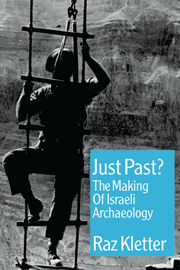Book contents
- Frontmatter
- Dedication
- Contents
- List of illustrations
- Introduction
- Acknowledgements
- Abbreviations
- 1 Archaeology and the 1948 War
- 2 Abandoned places, new places
- 3 Foreign aid
- 4 Frozen funds
- 5 A battalion of guards
- 6 Relief work
- 7 Man robs his land: “agreement” with General Dayan
- 8 “Gold of Ophir for Beth-Horon”: 3,000 shekels
- 9 The building beyond the border: the PAM, 1948–67
- 10 A building of dreams: a home for the IDAM and the origins of the Israel Museum, Jerusalem
- 11 A dead man on the council: the story of the supreme archaeological body in Israel
- 12 “But trust comes from the heart”: travels with the Government Tourist Corporation
- 13 “Whether in a courtyard of a synagogue, in a courtyard adjacent to a synagogue, or under a synagogue”: the Safad affair
- 14 The policy of salvage and early Israeli excavations
- 15 Myths and conclusions
- Appendix: other documents from the IDAM files
- Bibliography
- Author index
- Index
9 - The building beyond the border: the PAM, 1948–67
- Frontmatter
- Dedication
- Contents
- List of illustrations
- Introduction
- Acknowledgements
- Abbreviations
- 1 Archaeology and the 1948 War
- 2 Abandoned places, new places
- 3 Foreign aid
- 4 Frozen funds
- 5 A battalion of guards
- 6 Relief work
- 7 Man robs his land: “agreement” with General Dayan
- 8 “Gold of Ophir for Beth-Horon”: 3,000 shekels
- 9 The building beyond the border: the PAM, 1948–67
- 10 A building of dreams: a home for the IDAM and the origins of the Israel Museum, Jerusalem
- 11 A dead man on the council: the story of the supreme archaeological body in Israel
- 12 “But trust comes from the heart”: travels with the Government Tourist Corporation
- 13 “Whether in a courtyard of a synagogue, in a courtyard adjacent to a synagogue, or under a synagogue”: the Safad affair
- 14 The policy of salvage and early Israeli excavations
- 15 Myths and conclusions
- Appendix: other documents from the IDAM files
- Bibliography
- Author index
- Index
Summary
Much has been written about the establishment of the Palestine Archaeological Museum (PAM), commonly called the Rockefeller Museum, during the British Mandatory period, but very little about its fate after 1948. In this chapter some parts of this unknown history are described. In some aspects they bring to mind V. S. Naipaul's marvellous tragi-comic story “A House for Mr Biswas” (Naipaul 1969: 7).
The establishment of the PAM was a landmark in the history of archaeology in Palestine. In 1917 the Ottoman authorities planned to transfer about 6,000 antiquities from Jerusalem to Istanbul. Failing at the last moment, they left them packed in Jerusalem. The British decided to exhibit them and this became the kernel of a museum for Palestine (Phytian-Adams 1924). In 1929 John D. Rockefeller Jr. donated 2 million dollars for the museum. He first offered his donation to Cairo, but the negotiations there did not succeed. The PAM was built in 1930–38 with Austen St Barbe Harrison as architect and with Eric Gill doing some of the interior design. Their genius is still evident today, after seventy years. The building was made of quality materials in a neo-Gothic style, mixing Eastern and Western features. The museum was supported by an annual endowment and served all ethnic groups in Palestine (Harrison 1935; Iliffe 1938, 1949; Reich 1987, 1992b, 2001; Sussman & Reich 1987; Reich & Sussman 1993). With the deterioration of relations between the factions in Palestine the joints were severed.
- Type
- Chapter
- Information
- Just Past?The Making of Israeli Archaeology, pp. 174 - 192Publisher: Acumen PublishingPrint publication year: 2006



